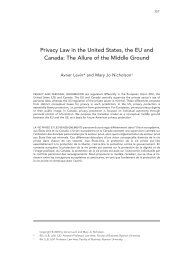The Criminal Phenomenon on the Internet: Hallmarks of ... - uoltj
The Criminal Phenomenon on the Internet: Hallmarks of ... - uoltj
The Criminal Phenomenon on the Internet: Hallmarks of ... - uoltj
Create successful ePaper yourself
Turn your PDF publications into a flip-book with our unique Google optimized e-Paper software.
(2008) 5:1&2 UOLTJ 125<str<strong>on</strong>g>The</str<strong>on</strong>g> <str<strong>on</strong>g>Criminal</str<strong>on</strong>g> <str<strong>on</strong>g>Phenomen<strong>on</strong></str<strong>on</strong>g> <strong>on</strong> <strong>the</strong> <strong>Internet</strong> 131Mainstream findings support <strong>the</strong> view that insiders are more likely to beinvolved in computer crimes against <strong>the</strong> employers’ systems. <str<strong>on</strong>g>The</str<strong>on</strong>g> Nordic Council<strong>of</strong> Ministers found that students, employees and self-employed people c<strong>on</strong>stitute<strong>the</strong> highest percentage <strong>of</strong> internet users. 25 Mackenzie and Goldman reportedthat “some students, particularly computer science and engineering majors,with newly discovered skills attempt to break into <strong>the</strong> servers” <strong>of</strong> University <strong>of</strong>Delaware. 26 In November 2003, Meta Group found that, <strong>of</strong> more than 1,600informati<strong>on</strong> and communicati<strong>on</strong>s technology pr<strong>of</strong>essi<strong>on</strong>als, current employeesrepresent <strong>the</strong> biggest threat to technology infrastructures. 27 <str<strong>on</strong>g>The</str<strong>on</strong>g> ComputerSecurity Institute and Federal Bureau <strong>of</strong> Investigati<strong>on</strong> found that 55 percent <strong>of</strong>survey resp<strong>on</strong>dents reported malicious activity by insiders. 28 Researchers alsorevealed that dissatisfied employees are a major source <strong>of</strong> computer crimes 29and are <strong>the</strong> greatest threat to a computer’s security. 30 When Su<strong>the</strong>rland coined<strong>the</strong> term “white-collar crime” in <strong>the</strong> late 1930s, he could have hardly imaginedthat crimes would be committed in <strong>the</strong> process <strong>of</strong> human-machine interacti<strong>on</strong>, inadditi<strong>on</strong> to human-human interacti<strong>on</strong>, human-organizati<strong>on</strong> interacti<strong>on</strong>, or humanacti<strong>on</strong> against machines. Never<strong>the</strong>less, <strong>the</strong> term “white-collar cybercrime” wasrecently introduced as a c<strong>on</strong>tributi<strong>on</strong> to develop Su<strong>the</strong>rland’s <strong>the</strong>ory. 31Besides <strong>the</strong> revealed relati<strong>on</strong>ship between criminals and victims, o<strong>the</strong>rshave also explored <strong>the</strong> characteristics <strong>of</strong> victims. Debra Littlejohn Schindersuggests a summary <strong>of</strong> comm<strong>on</strong> cybervictim characteristics: <strong>the</strong>y are new to <strong>the</strong>internet; naturally naïve; disabled or disadvantaged; greedy; l<strong>on</strong>ely or emoti<strong>on</strong>allyneedy; pseudo-victims in <strong>the</strong> sense that <strong>the</strong>y may falsely report being victimized;or are simply unlucky enough to be in <strong>the</strong> wr<strong>on</strong>g virtual place at <strong>the</strong> wr<strong>on</strong>g time. 32From <strong>the</strong> previous literature, <strong>the</strong> pr<strong>of</strong>ile <strong>of</strong> <strong>the</strong> cybercriminal and <strong>the</strong>cybervictim can hardly be regarded as settled. In additi<strong>on</strong>, <strong>the</strong> available literaturedoes not provide detailed sources <strong>of</strong> materials nor does it clarify <strong>the</strong> methodsused. Many studies have apparently been based <strong>on</strong> sec<strong>on</strong>d-hand materials andmass media reports. <str<strong>on</strong>g>The</str<strong>on</strong>g>re is still a need for findings about <strong>the</strong> hallmarks <strong>of</strong>cybercriminals and cybervictims drawn from <strong>the</strong> prosecuted cases.25. “Nordic Informati<strong>on</strong> Society Statistics 2005,” supra note 12 at p. 42.26. Elizabeth MacKenzie and Kathryn Goldman, “Computer Abuse, Informati<strong>on</strong> Technology, and JudicialAffairs,” in Proceedings <strong>of</strong> <strong>the</strong> 28th Annual ACM SIGUCCS C<strong>on</strong>ference <strong>on</strong> User Services: Building <strong>the</strong>Future (ACM Press, 2000) 170–176 at p. 174.27. Meta Group, “Security Spending Spree,” (20 January 2004) 23:1 PC Magazine 25.28. Bill Hancock, “Security Views,” (1999) 18:3 Computers and Security 188-189.29. Michael A Vatis (Director, Nati<strong>on</strong>al Infrastructure Protecti<strong>on</strong> Center, Federal Bureau <strong>of</strong> Investigati<strong>on</strong>),Statement for <strong>the</strong> Record, NIPC Cyber Threat Assessment, hearing, Senate Judiciary CommitteeSubcommittee <strong>on</strong> Technology and Terrorism, 106th C<strong>on</strong>gress, 1st sessi<strong>on</strong> (USA, 6 October 1999) at “InsiderThreat.”30. Eric J Sinrod and William P Reilly, “Cyber-Crimes: A Practical Approach to <strong>the</strong> Applicati<strong>on</strong> <strong>of</strong> FederalComputer Crime Laws,” (2000) 16:2 Santa Clara Computer and High Technology Law Journal 177–232.31. See for example, Victim Assistance Online, “White Collar Cybercrime,” . <str<strong>on</strong>g>The</str<strong>on</strong>g> term “White-Collar Hacker” is also used, for example, by John Leyden, “<str<strong>on</strong>g>The</str<strong>on</strong>g> Rise <strong>of</strong>White Collar Hacker,” (31 March 2004) <str<strong>on</strong>g>The</str<strong>on</strong>g> Register,.32. Debra Littlejohn Shinder, Scene <strong>of</strong> <strong>the</strong> Cybercrime: Computer Forensics Handbook (Syngress Publishing, 2002).









